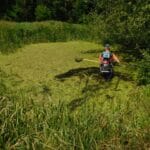A skilled dermatologist will diagnose a keloid just by looking at it. In some cases, such as skin growth that raises concerns, your dermatologist might need to perform a biopsy on said tissue. He or she will easily remove a miniature part of the potential keloid and study it under a microscope to conclude if it really is a keloid.
If you have concerns on a potential keloid, you should make an appointment with a consultant dermatologist in Singapore to get a qualified diagnosis and treatment plan.
Keloids Treatment
The biggest scare in keloid treatment is potential scars that are hard to hide and even harder to get rid of. That is why your dermatologist might propose a combination of two or three treatments.
But, before you get to the treatment itself you will need to figure out your realistic expectations. You need to meditate on the following questions to get a clearer picture:
- Is getting rid of pain your biggest priority, or is it the itchiness?
- What works better for you, flattening or softening your keloid?
- In the case that your keloid is located on your ear, are you prepared to possibly not wear earrings again?
One of the most important pieces of information you can give your dermatologist is your previous experiences with keloids. If you have had them before it is essential to communicate that clearly with your dermatologist.
What a Comprehensive Keloids Treatment Looks Like
Injections – The most common type of injection are corticosteroids. The injections are taken once every 20 or 30 days, with a total of 4 injections used. If they work, they should shrink the keloid after each treatment. Between half and two-thirds of all keloids treated this way disappear. However, there is a chance that a keloid will regrow in the next few years and it is best to combine this treatment with a few others.
Keloid surgery – It would seem logical that the keloid won’t recur after full removal via surgery, but this is rarely the case. That is why dermatologists usually combine this treatment with injections or/and some sort of therapy, usually radiation or cryotherapy.
Radiation – One of the most successful secondary keloid treatment following a keloid surgery. It reduces the chances of a keloid regrowing immensely.
Cryotherapy – Freezing the keloid from the inside, this treatment helps to minimize any damage that the skin below the keloid might receive. It works best with small keloids.
Laser treatment – Combined with injections or pressure, this treatment can successfully shrink the size of a keloid as well fade its colour.
Compression earrings, dressing, or garment – Most commonly used after a keloid surgery. This combination is one of the most successful ones. It can stop the reappearance of a keloid up to 90% of the time. But, they can be quite painful. Especially when you consider that you have to wear them between half a year and a whole year.
Silicone gels or sheets – Combined with the pressure to minimize regrowth
Ligature – A ligature is a surgical thread that is tied around your keloid which cuts it off over time, eventually removing the keloid. A new surgical thread will need to be tied every two weeks.
Other possible treatments – As medical research continues, your dermatologist might suggest some new, revolutionary methods that we have not yet mentioned.
What to Expect Post Keloid Treatment
Depending on the success rate of your treatment you can expect different results. If everything goes ideally, you will be completely rid of a keloid. If that fails, your keloid might still shrink significantly, and the pain and itchiness that you experience might go away for good.
Be sure to follow all medical advice from your dermatologist. This is the only way to minimize the odds of a keloid returning after treatment.
Senior Outlook Today is your go-to source for information, inspiration, and connection as you navigate the later years of life. Our team of experts and writers is dedicated to providing relevant and engaging content for seniors, covering topics such as health and wellness, finances, technology and travel.





